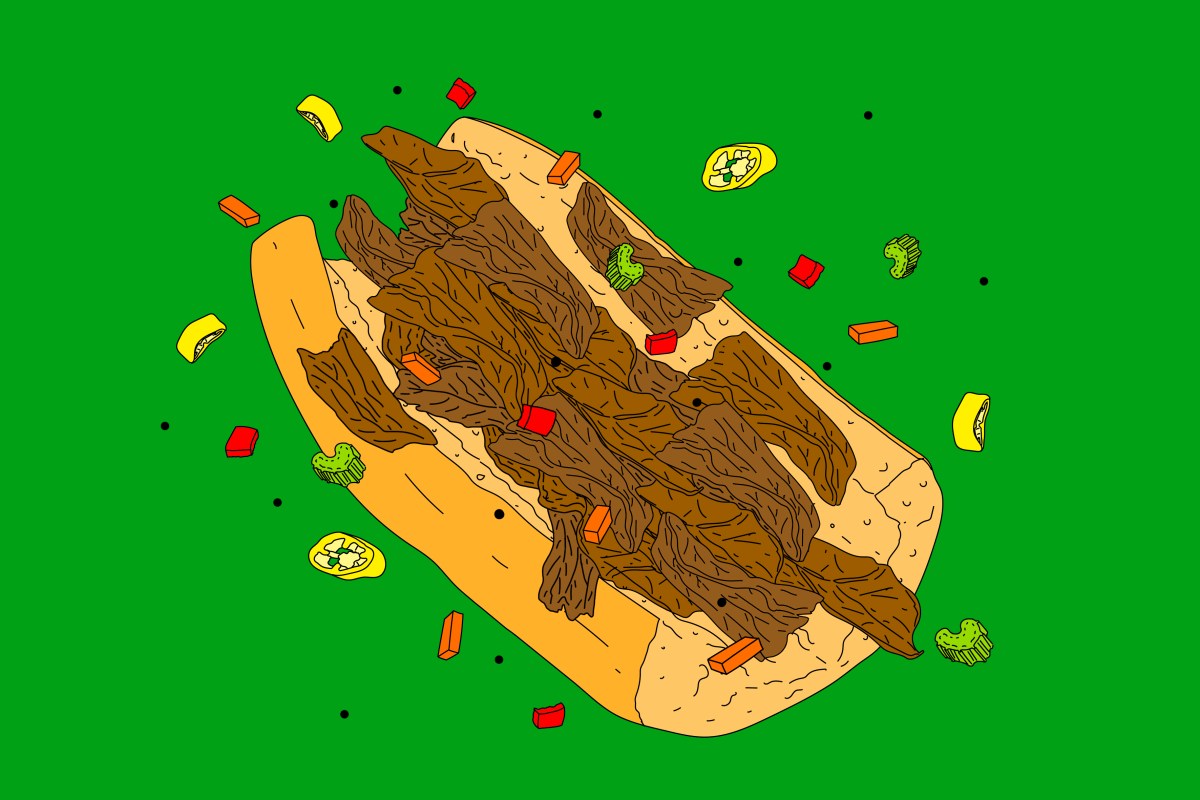Update, 8/15/22: The mighty Chicago-Style Italian beef sandwich’s quest for nationwide domination continues, thanks to the success of Hulu’s The Bear — the buzzy and at times nerve-wracking Chicago-based series about a Michelin-level chef who returns home to take over his late brother’s no-frills Italian beef joint. Since it debuted on June 23, it’s got real-life chefs praising the way it nails the restaurant industry, folks clamoring to purchase their own version of Carmy’s wool jacket and of course, the rest of us thirsting over the protagonist on social media. But most significantly, it has allowed the Italian beef to finally get its moment in the sun. Since the show has given the sandwich a little more nationwide attention, sales of it have increased by as much as five or six times what they used to be at some restaurants, and orders at online retailers like Goldbelly, which ships specialty items from around the country are up 30% so far. (That’s a whole lot of giardiniera to get prepared.) If you ask us, it’s about time the delicious local classic becomes a nationwide culinary sensation. Below, read our definitive history of Chicago’s signature sandwich.
In the U.K. and Canada, they call it Boxing Day, but in my Chicago family, the day after Christmas is something else entirely: Beefmas. The rules of this sacred, completely-made-up holiday are pretty simple: every Dec. 26, my brother and I go see a movie, and then we get Italian beef sandwiches. The tradition began about 10 years ago, when I first moved out of state and started craving the thinly sliced beef and the hot, wet mess of giardiniera and bread dipped in gravy every time I came home for a visit. The Italian beef — also referred to lovingly as simply a beef — isn’t just a local delicacy; it’s a part of my family lore, from the time my brother served one to former Bears quarterback Rex Grossman when he was working at our local Portillo’s in high school to our more recent interactions under quarantine, when my mom presented me with a hand-drawn voucher for one big beef sandwich (wet, with hot peppers) as a prize for correctly guessing which cousin the “mystery guest” in our weekly Zoom call would be.
Outside of Illinois, however, it’s a different story. While other Windy City staples like Chicago-style pizza and the Chicago-style hot dog have earned nationwide notoriety, the Italian beef hasn’t become as ubiquitous as other regional specialties. You can find a Philly cheesesteak, for example, just about anywhere; tracking down an Italian beef outside the Midwest is more difficult — though it can be done. As Emmett Burke, a native Chicagoan who opened up Emmett’s in New York City in 2013 to champion the cuisine he grew up with, points out, East Coast acolytes of the Italian beef are a small but highly devoted bunch.
The main draw at Emmett’s is its pizza (both deep dish and Chicago tavern style), but Burke says he often gets large catering orders from former Chicagoans now living in New York looking to spread the beefy gospel. “People who know, know,” he tells InsideHook with a laugh.
Let’s assume, for a moment, that you don’t know. The Italian beef dates back to the early 1900s, when Italian immigrants working at Chicago’s Union Stock Yards in the city’s meatpacking district would bring home some of the cheaper, less desirable cuts of meat. To soften up those tough cuts of beef and make them more palatable, they would slow-roast them and simmer them in a broth with Italian spices to add flavor, then slice them thinly across the grain and serve on a sandwich (often at weddings and banquets, in order to make a small amount of meat go a long way). There’s some debate over who first began selling the Italian beef in Chicago, but the earliest purveyors include Pasquale Scala, who opened the Scala Packing Company in 1925, and the famous Al’s Beef, opened by Al Ferreri, his sister Frances, and her husband, Chris Pacelli, Sr., in 1938. Other local favorites followed in the ’60s, with Mr. Beef opening in 1961 and Portillo’s setting up shop in 1963.
There are several variations and plenty of terminology to familiarize yourself with before ordering: Italian beefs are either served hot (meaning topped with Chicago-style giardiniera, a spicy blend of chopped, pickled peppers and veggies) or sweet (topped with sweet green peppers). You’ll also need to decide whether you want it dry or wet (also referred to sometimes as dipped), meaning the sandwich is dunked in au jus (called “gravy” by locals). A juicy beef is served even wetter, and a soaked one is, well, exactly what it sounds like.
How you order your beef is a matter of personal preference, but if you’re looking for the most authentic way to go, Burke says it’s hot and wet. (Sara Wirth, a Portillo’s spokesperson, estimates that 40 percent of the chain’s customers order their Italian beef dipped.)
“For me, a perfect Italian beef comes down to the perfectly cooked beef, dipped, with giardiniera,” he says. “Every element is so important.”
Burke insists that quality ingredients are ultimately what draw people to the no-frills sandwich. “Ultimately, it’s roast beef reheated in its own juices. But it’s about making sure you’ve got quality ingredients, from the beef to the giardiniera to the bread.”
That attention to ingredients is why Portillo’s, which has over 60 locations, sources all of its beef from the same spot. “All of our Italian beef comes from our kitchens in Aurora and Addison, Illinois,” Wirth says. “We slice more than 1 million pieces of Italian beef per day at these kitchens. And because it is all produced in our kitchens, Portillo’s guests are getting a consistent product no matter which location they visit.”
Though it’s mostly known as a Midwestern establishment, Portillo’s does have locations in Arizona, California and Florida as well, serving up beef to the legions of former Chicagoans who fled the city’s harsh winters for warmer climates. And prior to the coronavirus pandemic, the chain was hoping to educate more people nationwide about all things Italian beef with the Beef Bus, a traveling food truck whose destinations would be determined by fans voting online.
“Our fans were the inspiration for the Beef Bus,” Wirth says. “We get requests to open Portillo’s locations everywhere from small towns to big cities across the country. This was our way of bringing Portillo’s to them, even if we can’t open a restaurant there quickly. This is a way to make sure our fans get heard, and a way for them to get their towns behind having Portillo’s come visit. While it is not currently operating due to the COVID-19 pandemic, it’ll be back in action as soon as we can safely return.”
But while Chicagoans and their expat brethren love their Italian beef — as Wirth notes, Portillo’s sells an average of 550 Italian beef sandwiches at each of its locations per day — getting those who are unfamiliar with the sandwich to try it can sometimes be tricky.
“They don’t know what it is,” Burke says. “They say, ‘Is it a cheesesteak? Is it messy? What is this?’”
Part of that, he says, stems from Chicagoans’ Midwestern tendency to not talk themselves up. “Chicago and New York have this strange rivalry,” he says. “And New Yorkers can sometimes have this cockiness, where it’s all about being the best. Chicagoans have a little bit of a chip on our shoulder — you know, we’re the ‘Second City,’ that kind of thing — but I think there’s also this Chicago thing of being in the know and knowing you’re the best but not saying anything about it.”
Once they’ve been convinced to try an Italian beef, most people tend to love it, and while Burke says that “it just hasn’t been done on a level [outside of Chicago] that does it justice,” he’s convinced that the sandwich has the potential to become trendy nationwide.
“It’s good food,” he says. “Someone with a good palate, when they try it, it’s appreciated. It hasn’t had its moment, but when people try it, they love it. It will have its moment.”
“I bet my whole life and career on it having its moment,” he adds. “We’re working on opening a second location, and we’re hoping that with the second location we can really highlight the Italian beef and the hot dogs, raise awareness about these other beloved Chicago foods beyond the pizza. One day, Italian beef will get the attention and the respect it deserves.”
Of course, getting your hands on an Italian beef if you live outside the Chicago area is a little more complicated these days due to the COVID-19 quarantine. (Emmett’s is currently open for takeout and delivery with a limited menu of pizza, wine and beer.) With that in mind, Burke has provided the following recipe so you can try to replicate the beloved sandwich at home.
Emmett’s Own Italian Beef
“This is a big sense of pride for any Chicagoan and something we take very serious here at Emmett’s,” Burke says. “While we started with deep dish pizza, we knew that Chicagoans are very particular about their Italian beef. Like everything on the menu at Emmett’s, the recipe came together in the kitchen of my apartment on Bleecker Street in the West Village. I did a lot of research and beef eating and found the cut of beef recommended was sirloin, top or bottom rounds.”
What you’ll need:
- 3 lbs of top roast beef
- 2 green bell peppers
- 1 clove of garlic
- 1 teaspoon onion salt
- 1 teaspoon dried Sicilian oregano
- 1 tablespoon salt
- 1 teaspoon ground black pepper
- 1 teaspoon dried basil
- 1 teaspoon of crushed red pepper
- 1 teaspoon dried parsley
- 1 teaspoon garlic powder
- 1 bay leaf
- 4 cubes of beef bouillon
- 5 cups of water
- 10 French rolls (high gluten) (“I prefer Turano,” Burke says. “Gonnella is good too. A soft French roll will do the trick. Make sure it’s not too hard because it won’t absorb the gravy.”)
Directions: - Leave the beef out for about an hour to get to room temperature
- Preheat oven to 400 degrees
- Cut slivers in the beef and fill with garlic cloves
- Combine all spices for your rub
- Put beef in 9″ by 13″ baking pan
- Use 3/4 of the rub and put all over the beef
- Heat 5 cups of water to a boil in a separate pot and put in bouillon and dissolve
- Combine bouillon water and remaining spices in the baking pan
- Put in the over for 2.5 to 3 hours (rule of thumb is 30 minutes for each pound of beef). Wait until it gets to 135-140 degrees. Best to use a meat thermometer.
- Once the beef gets to temp, take out and let sit and rest for about 30 minutes. Keep the gravy/juice.
- Because you will be slicing this extra thin, wrap up/cover and put in fridge overnight
- If you have a meat slicer at home (who does?), it’s best to slice. Otherwise, slice the beef as thin as you can.
- Warm the gravy/juice to a low simmer, put the beef in there for no more than seven minutes. This gives a good soak and gets it to a nice, warm temperature.
- For a dipped beef, dip the sandwich in the warm gravy, top with giardiniera (“I would buy the giardiniera from Amazon,” Burke advises. “Vienna Beef and Marconi are both good brands”) and serve.
Join America's Fastest Growing Spirits Newsletter THE SPILL. Unlock all the reviews, recipes and revelry — and get 15% off award-winning La Tierra de Acre Mezcal.
























